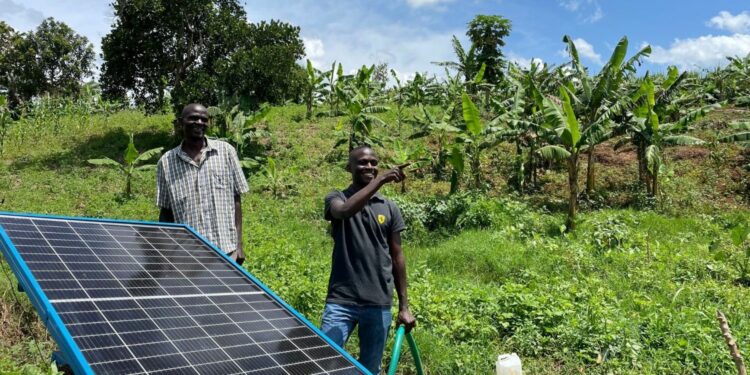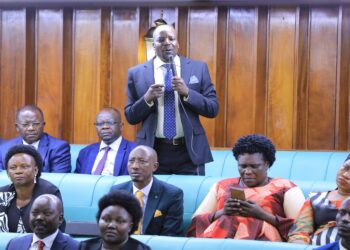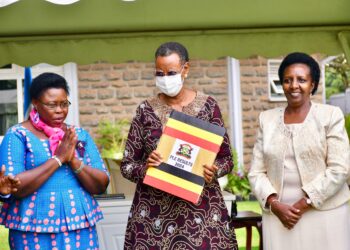Despite the increasing impacts of climate change, which threaten agricultural productivity across Uganda, the country’s adoption of irrigation technologies remains strikingly low.
With only about 2% of Ugandan farms utilizing irrigation, the government is working to shift this trend by implementing a subsidy program aimed at facilitating small-scale solar-powered irrigation systems. Supported by the World Bank and managed by the Ministry of Agriculture, Animal Industry, and Fisheries, the initiative seeks to enhance climate resilience and boost agricultural commercialization in Uganda.
The solar-powered irrigation systems offer farmers a solution to the growing unpredictability of rainfall and climate extremes, reducing reliance on expensive petrol or diesel pumps. However, experts caution that while solar-powered irrigation can provide long-term cost savings, there are concerns about its potential to encourage unsustainable groundwater extraction. According to researchers Edward Kato and Claudia Ringler from the International Food Policy Research Institute (IFPRI), while there is no evidence of excessive groundwater use in sub-Saharan Africa, the long-term sustainability of solar-powered irrigation remains an important issue for future consideration.
These senior researchers point out that despite the potential benefits, several questions remain, particularly about its impact on smallholder farmers, women farmers, and the overall viability of the program as a business model. Initial concerns revolve around whether these farmers can equitably access the technology and whether the subsidy program can effectively reach those who most need it.
Claudia Ringler, the co-lead of the CGIAR Initiative on NEXUS Gains Initiative, Geoffrey Kiguli, George Sentumbwe, Dennis Tiishekwa, Abdul Nsereko, and Jennifer Alinaitwe all attached with Homeland Data Services, Uganda suggest that this subsidy program has garnered significant attention, with over 80,000 applications submitted from across Uganda’s 66 districts. As of December 2024, around 4,000 solar-powered irrigation systems have been installed, and demand continues to grow.
However, they say, the program’s financial requirements are a significant barrier for many farmers. Farmers are expected to co-finance 25% of the total cost of a solar pump, with prices ranging from 4 million Ugandan shillings (about $1,100) to 14 million shillings (approximately $3,800). This co-financing requirement presents a serious challenge, especially for poorer farmers who may not have easy access to savings, credit, or bank loans.
This financial hurdle is compounded by the reality that many farmers lack access to land with reliable water sources, such as streams, lakes, or boreholes. With the impacts of climate change worsening, agricultural land that already has water access is increasingly out of reach for average Ugandan farmers, further restricting access to the solar irrigation systems. In addition, the application process, which involves submitting documents through a smartphone app, has proven difficult for smallholders who may not have the necessary technology or skills.
As a result, the early beneficiaries of the program have tended to be wealthier farmers, including local elites, businesspeople, and members of Uganda’s diaspora. However, as the program expands, it is gradually reaching less affluent farmers.
Solar Pumps Boost Household Water Security
Initial feedback from the subsidy program suggests that the solar-powered pumps are providing more than just irrigation for crops. Many beneficiaries are also using the systems for livestock production and household water needs, thereby enhancing their overall water security. This broader use of solar pumps is increasing the return on investment for farmers.
However, the customization of the solar pumps for individual farm needs has limited the potential for water sharing between farmers, unlike in South Asia where oversized solar pumps allow farmers to sell excess water to neighboring farmers. In Uganda, none of the survey respondents reported providing water to others, which further limits the social and economic benefits of the technology. While this could be seen as a drawback, it reflects a more tailored approach to meet specific farm requirements in Uganda, rather than a one-size-fits-all model.
Moreover, the adoption of solar-powered pumps has led to increased production of high-value crops like fruits, vegetables, and coffee, potentially boosting household income and improving agricultural diversity.
Addressing Key Challenges
Despite the successes, several bottlenecks remain. One of the most pressing issues is the lack of adequate solar pump repair services in rural areas. Farmers have reported that some of their solar pumps have broken down without available repair options, and those that do exist often offer poor-quality services. A shortage of spare parts exacerbates this problem, leaving many farmers unable to make repairs themselves.
In response, experts suggest that the government should work closely with technical schools to establish training programs for technicians, creating job opportunities for youth and ensuring a skilled workforce to service the growing number of solar-powered pumps. This could help prevent the abandonment of systems due to lack of maintenance and repair services.
Another critical issue is delays in the delivery of solar pumps. While some beneficiaries have reported receiving their systems within two to three months, others have had to wait up to seven months, which can disrupt the planting and harvesting cycles. Delayed deliveries are particularly problematic for farmers who have taken loans to cover the unsubsidized portion of the cost, as they begin repaying their loans without having had the opportunity to earn income from the new technology.
These experts suggest that one potential reason for these delays is the lack of a formal contractual relationship between solar pump suppliers and farmers. Solar pump providers tend to view the Ministry and local representatives administering the subsidy as their primary clients, rather than the farmers themselves.
This lack of incentive for private sector engagement in service provision has created a gap in the sustainability of the program. To address this, the government should consider developing incentives to encourage solar pump suppliers to establish a direct relationship with farmers.
As the solar-powered irrigation subsidy program in Uganda scales up, there is a need for a comprehensive review of the program’s structure and its implementation challenges.
A review of sustainable groundwater management practices and enhanced water governance systems could improve equitable access to water resources for all farmers.
Do you have a story in your community or an opinion to share with us: Email us at editorial@watchdoguganda.com













